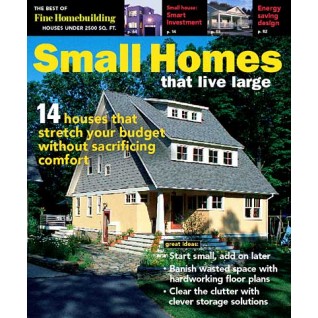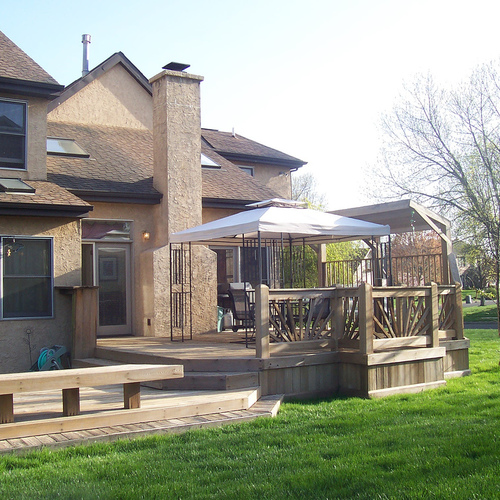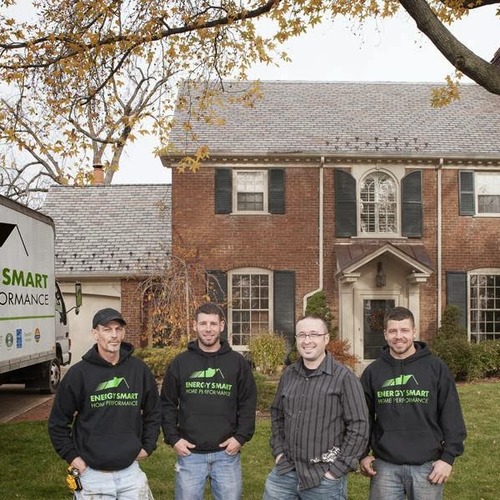
Being surrounding in the pages of GBA by a lot of folks whose credentials make mine pale in comparison, I have to be sure never to wander too far from home. And the perspective I am privileged to represent here is one of “Business Advisor,” which means you won’t see me straying too far afield into Building Science, Sustainable Design, or God knows else I would like to pontificate on but that may be outside my purview.
Thus, when I consider “big vs. small: which is greener?” I want to respect the different directions this question can be approached from and focus my firepower on the business case for or against the subject at hand. And for me, it’s a no-brainer. When it comes to green, smaller is better. (Oops! I mean greener! Oh, well.) Here’s why.
All things being equal, a smaller home will take less time to build than a larger home. A home built in less time means that the client moves in sooner, gets back to normal more quickly, is productive at work faster, and benefits from the energy efficiency and healthy features in the home more immediately. As well, the neighbors have the construction crews out of their lives that much faster, the local government is earning tax revenue, and the client’s kids are back in school earning straight As! And smaller homes require fewer resources to build and operate over the course of their lifetimes.
Smaller jobs are completed faster
All well and good, but where’s the business case for smaller is greener, you ask? Let’s be selfish here for a moment and consider why it is better for business to build smaller. Because a home built in less time means that I earn my compensation for building it more quickly. And if I can earn 12 months of salary in 11 months, even better. Building mansions and McMansions (green or otherwise) can have its own rewards — and in many cases, those rewards can be financial — but let’s put assumptions aside and look more closely.
Does a $3M home built over 30 months make more sense than a $650K home built over five months? The former generates revenue of about $ 23K/weekly, and the latter, $32K/weekly. What about gross profit? When you look to see if a potential project is right for you, do you look at the gross profit it will generate for you on a weekly basis? I know having $3M on the books for the next 30 months has it own rewards, which cannot be overlooked (improved cash flow, an ability to pay down debt, freed up resources for long-term strategic planning, to name a few), but please do not let that override other important metrics.
Calculate your anticipated gross profit
For a variety of reasons, I turned down the opportunity to bid on a custom ICF home earlier this year. It was a 90-minute drive from my office, the client insisted on a free bid, did not want to pay me for services, and only wanted to pay cost plus 10% on a $1.5M home! At the end of the phone call, I was very straightforward and explained that I could not go to my partners and justify the deal. A gross profit of $150K on a home that would take at least 12 months to build wouldn’t make sense when we could kick out five remodels for the same price and gross more than three times that in the same period of time. Not to mention we would have more net profit on the smaller projects because we would not have to drive so far and we would have a lot less liability exposure than if we were building a big ICF home.
Turnover is the key, and if you don’t do the math, you may be tying up resources on projects that generate lower sales or gross profit dollars than could be generated elsewhere. Your Building Advisor is telling you: Big is not always better, and there is a lot of green to be made in building smaller!
Weekly Newsletter
Get building science and energy efficiency advice, plus special offers, in your inbox.















5 Comments
it needs to make business sense
I'm probably typical in that my background is design and once I entered the professional world I came to the hard realization that business skills are more important than design skills if you want to run an architecture firm. So this category of blog is educational for me.
I observe that the US compared to some other countries I am familiar with (Korea, Mexico) the labor and professional service cost is high. (I'm not aware of the comparisons in material's cost).
When we start talking about 'green' we are talking about improving the way we design and build. This typically means more time and better materials. Costs go up and therefore there is a market pressure to only "do green up until a certain cost".
The premium on costs can be addressed by lower cost labor and lower professional fees. While I am concerned about the shrinking middle class in the US, I am also of the opinion that the average American enjoys greater consumption of goods compared to most of the world. I wonder if any business savvy people out there have determined an "appropriate" livable income that enabled them to lower there fees enabling them to accomplish the quality of work that meets higher principles.
(Note: my perspective is based in cold climates where space heating represents a major area of energy consumptions) Small houses are better than big houses but each small house requires all the infrastructure needed to service an entire building and its tenants. Multi-units are better than small houses in this regard but I suppose than we are talking an entirely different market- developer/land owners vs. residential clients/ homeowners.
I'd like to see middle ground financial options for a residential client candidate to instead construct a 3-4 unit residence for a live rent situation. Co-operatively owned multi-residences also would be interesting to see. These represent efficiencies well beyond small single family homes and avoid large corporate land holdings an apartments with less than ideal living conditions.
Heard something interesting the other day about mammals sizes. Elephants are by many factors much more efficient than mice in terms of caloric energy needed per pound to sustain the entire system. So if you have enough mice to make up the weight of an elephant you'll be needing alot more cheese ; )
Large Homes
I think you made the right decision on the cost plus 10% job, especially since it was 90 minutes away. As to the issue of large homes taking 30 months, one way to handle this is to charge a monthly fee (in addition to any markup or profit) for overhead and supervision. I see that a lot on larger custom homes here in Houston, that is becoming pretty standard. If the house takes an extraodinary amount of time, at least you are covering some costs.
Re: No TV Shows Glamorizing Smaller Living Spaces
Unfortunately there are no TV shows glamorizing smaller living spaces or life style and health benefits of energy efficient ones.
"No TV Shows Glamorizing Smaller Living Spaces"
Frank, you must have missed "Little House on the Prairie" :)
LIttle TV Houses
I was thinking of the Little Shop of Horrors!
Log in or create an account to post a comment.
Sign up Log in